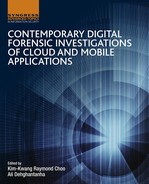Network Traffic Forensics on Firefox Mobile OS
Facebook, Twitter, and Telegram as Case Studies
M.N. Yusoff*; A. Dehghantanha†; R. Mahmod‡ * University Science Malaysia, George Town, Malaysia
† University of Salford, Salford, United Kingdom
‡ Universiti Putra Malaysia, Serdang, Malaysia
Abstract
The development of a mobile web-centric OS such as Firefox OS (FxOS) has created new challenges and opportunities for digital investigators. Network traffic forensics plays an important role in cybercrime investigation to detect subject(s) and object(s) of the crime. In this chapter we detect and analyze residual network traffic artifacts of FxOS in relation to two popular social networking applications (Facebook and Twitter) and one instant messaging application (Telegram). We utilized a FxOS simulator to generate relevant traffic while all communication data were captured using network monitoring tools. Captured network packets were examined and remnants with forensic value were reported. This paper, as the first focused study on mobile FxOS network traffic analysis, should pave the way for the future research in this direction.
Keywords
Firefox OS; Digital forensics; Mobile forensics; Network monitoring; Network traffic; Virtual environment
1 Introduction
The significant rise of social media networking, instant messaging platform, webmail, and other mobile web applications has spawned the idea to build mobile web-centric operating systems (OS) using different open web standards like HTML5, CSS3, and JavaScript. Due to that fact, Mozilla released the world's first mobile web-centric OS on Feb. 21, 2013. This mobile web-centric OS is based on the Firefox web browser rendering engine on top of a Linux kernel, called Firefox OS (FxOS) [1]. The emergence of a mobile web-centric OS has created new challenges, concentrations, and opportunities for digital investigators. In general, the growth of mobile devices may allow cybercriminals to utilize social media and instant messaging services for malicious purposes [2] such as spreading malicious codes and obtaining and disseminating confidential information. Furthermore, copyright infringement, cyber stalking, cyber bullying, slander spreading, and sexual harassment are becoming serious threats to mobile device users [3]. Therefore it is common to be confronted with different types of mobile devices during variety of forensics investigation cases [4].
Many previous studies were focused on the detection and analysis of network traffic artifacts for cyber forensics. Quick and Choo ran Dropbox cloud storage in virtual environment machine and all network activities were recorded [5]. Network Miner 1.0 [6] and Wireshark Portable 1.6.5 [7] were used to capture the network traffic in many circumstances and network traffic was seen on transmission control protocol (TCP) port 80 and 443 only. Quick and Choo also ran Microsoft SkyDrive in a virtual environment machine using the same method [8]. The results were tabled with more information such as IP start, IP finish, URL observed in network traffic, and registered owner. No usernames nor passwords were observed in the clear text network traffic. Quick and Choo continued the research and run Google Drive cloud storage as the case study [9]. The Google Drive account credential was observed but could not be seen in the network traffic, suggesting the data was encrypted. Martini and Choo observed network traffic from the virtual environment network adapter using ownCloud as a case study [10]. HTTP Basic authentications were captured and user's ownCloud credentials were successfully displayed. Farina produced an analysis of the sequence of network traffic and file I/O interactions in the torrent synchronization process [11]. Bittorrent client were used as the test subject.
Utilizing virtual machines for generating network traffic is very common in forensics research. Blakeley investigated cloud storage software using hubiC as a case study [12]. In the network analysis part it was observed that a redirect to HTTPS on port 8080 was returned when the initial request was made to https://www.hubic.com. This shows that there was no plaintext traffic accepted by the hubiC website. Shariati ran network analysis using SugarSync cloud storage [13]. The majority of communications were encrypted and no credentials nor contents of sample datasets were able to be recovered. Dezfouli investigated Facebook, Twitter, LinkedIn, and Google + artifacts on Android and iOS. During the experiment, network activities were captured and the user's IP address, the domain name of connected social media sites, and corresponding session timestamps were able to be determined. Yang identified network artifacts of Facebook and Skype Windows Store application [14]. Yang was able to correlate the IP addresses with the timestamp information to determine when the application was started up and the duration of the application used during the experiment. Daryabar investigated OneDrive, Box, Google Drive, and Dropbox applications on Android and iOS devices [15]. In the network analysis part the connections were secured between the cloud client application and the server, thus no credentials were able to be seen. Daryabar also investigated the MEGA cloud client application on Android and iOS [16]. Daryabar identify network artifacts arising from user activities, such as login, uploading, downloading, deletion, and file sharing including timestamps. Table 1 reflects the literature summary of network analysis and monitoring captured through virtual environment network adapter.
Table 1
Summary of Network Analysis and Monitoring Captured Through Virtual Environment Network Adapter
| Researcher(s) | Application(s) | Application Type |
| Martini and Choo [10] | OwnCloud | Cloud storage |
| Quick and Choo [8] | Dropbox | Cloud storage |
| Quick and Choo [17] | Microsoft SkyDrive | Cloud storage |
| Quick and Choo [9] | Google Drive | Cloud storage |
| Farina et al. [11] | Bittorrent | Torrent client |
| Blakeley et al. [12] | hubiC | Cloud storage |
| Shariati et al. [13] | SugarSync | Cloud storage |
| Dezfouli et al. [3] | Facebook, Twitter, LinkdIn, Google + | Social media |
| Yang et al. [14] | Facebook, Skype | Social media, VoIP |
| Daryabar et al.[15,16] | OneDrive, Box, Google Drive, Dropbox | Cloud storage |
| Daryabar et al. [15,16] | MEGA | Cloud storage |
As can be seen from Table 1, there was no previous study analyzing FxOS network traffic artifacts. FxOS is designed to allow mobile devices to communicate directly with HTML5 applications using JavaScript and newly introduced WebAPI. However, the use of JavaScript in HTML5 applications with solely no OS restriction might lead to security issues and further potential exploits and threats. FxOS is still not fully supported by most of the existing mobile forensic tools, which further stresses the urgency for further research development in this area [18].
In this chapter we were focused on the analysis of residual network traffic artifacts in FxOS. Two popular social networking applications (Facebook and Twitter) and one instant messaging application (Telegram) were investigated as case studies. In the earliest days investigators used to put the mobile phone in a special sandbox to monitor mobile GSM activities [19]. However, this method requires a lot of expensive devices and thus, the phone monitoring process became more complicated and very costly. The FxOS simulator is a virtualized version of the FxOS that provides full user experience and FxOS features. Therefore we have followed the method proposed by Quick and Choo and simulated FxOS in a virtual environment machine [17]. When we performed the communication activities using the FxOS simulator, we used the Network Analyzer to capture and monitor the network traffic.
The rest of this chapter is organized as follows. In Section 2 we explain the methodology used and outlined the setup for our experiment. In Section 3 we present our research findings and finally conclude our research in Section 4.
2 Experiment Setup
Network analysis is a procedure for investigating the movement of data that travel across the targeted network. This procedure was performed by analyzing and carving the captured network artifacts. In general, the collection of network artifact for mobile devices is very difficult because of the limitation of mobile hardware and mobile OS itself. It is in contrast with conventional desktop OS, which we can easily capture the network files using various tools available. For that reason alone, we have adapted an approach for forensic collection of cloud artifacts [8,9,17] into our research methodology. Quick and Choo analyzed several cloud applications using virtual machines and captured and analyzed network traffic activities. In this chapter we run the FxOS simulator within VMware (VM) [20], configured with two popular social networking applications (Facebook and Twitter) and one instant messaging application (Telegram); which we will perform communication tasks in different scenarios. All the network activities are then captured and analyzed using network analysis tools.
The FxOS Simulator is an add-on simulator for the Firefox browser that enables users to run FxOS on any desktop computer. It comes with the Dashboard, a tool hosted by Firefox web browser that enables users to start and stop the simulator; install and uninstall the applications; and to debug FxOS applications. The Dashboard is also used to push applications to a real device and checks application manifests for any common problems. Three applications that are two popular social networking applications (Facebook and Twitter) and one instant messaging application (Telegram) installed in the VM disk and communications activities were performed to detect and investigate residential artifacts. Separated VM disks were then created for every action taken and all the network activities were captured and monitored. Fig. 1 illustrates our experiments setup.
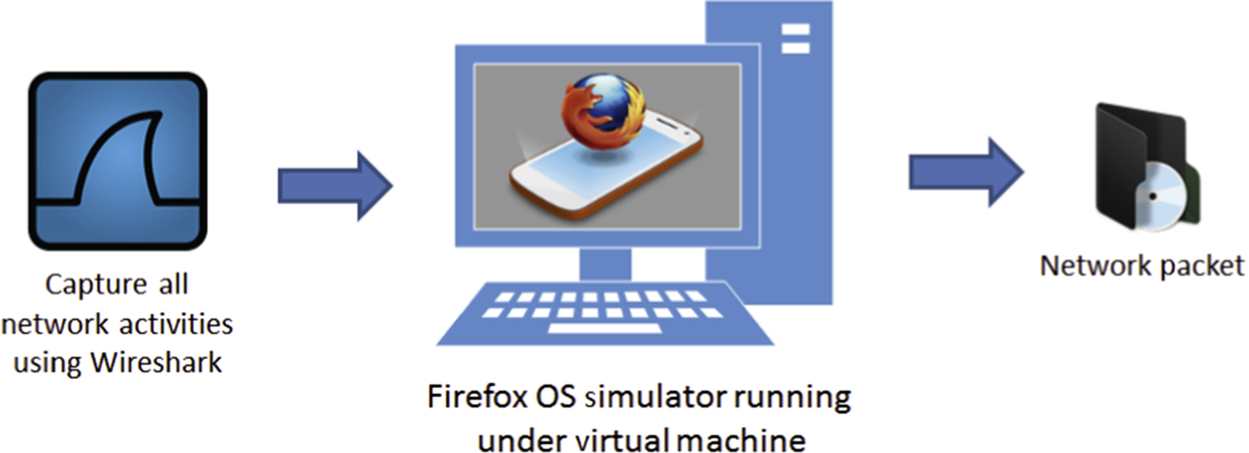
As the network analyzer captures all VM network activities, including Windows 8.1 services, we filtered out nonrelevant network data using Wireshark 1.12.5. Werepeated our investigation using Ubuntu 14.04 LTS and the network packets in both environment were complementarities. This research experiment setup was divided into four stages: (1) preparing virtual machines with selected applications; (2) executing the activities and documenting all steps taken; (3) capturing the network activities; and (4) conducting network analysis.
2.1 Preparing Virtual Machines
In this experiment we run the FxOS simulator on Windows 8.1 and Ubuntu 14.04 LTS utilizing VM Player 10.0.1. Our experiments were mainly focused on applications that regularly stimulate user communications and applications usage. We configured two popular social networking applications (Facebook and Twitter) and one instant messaging application (Telegram) as our test subjects. Several tasks were performed in different sets of scenarios and all the network activities were captured using Wireshark 1.12.5 and Microsoft Network Monitor 3.4 [21]. For the analysis part we used the Network Miner 1.6.1 to carve related network artifacts. Table 2 shows all the software and applications that were used in our experiment.
Table 2
Software and Applications for FxOS Network Traffic Investigation
| Software or Application | Purpose |
| Windows 8.1 | Operating system |
| Ubuntu 14.04 LTS | Operating system |
| VMware Player 10.0.1 | Provides virtual environment |
| Wireshark 1.12.5 | Capturing and monitoring network activities |
| Microsoft Network Monitor 3.4 | Monitoring network activities |
| Network Miner 1.6.1 | Carving and identifying evidences from network packets |
| Test application (social media) | |
| Test application (social media) | |
| Telegram | Test application (instant messaging) |
As shown in Fig. 2, a total of 11 VMs on 11 physical systems were created for Windows and Ubuntu, respectively. Each VM disk represents a scenario in our experiment. All VM disks were configured with Windows or Ubuntu installed on 20 GB virtual hard drive and equipped with 1 GB RAM.
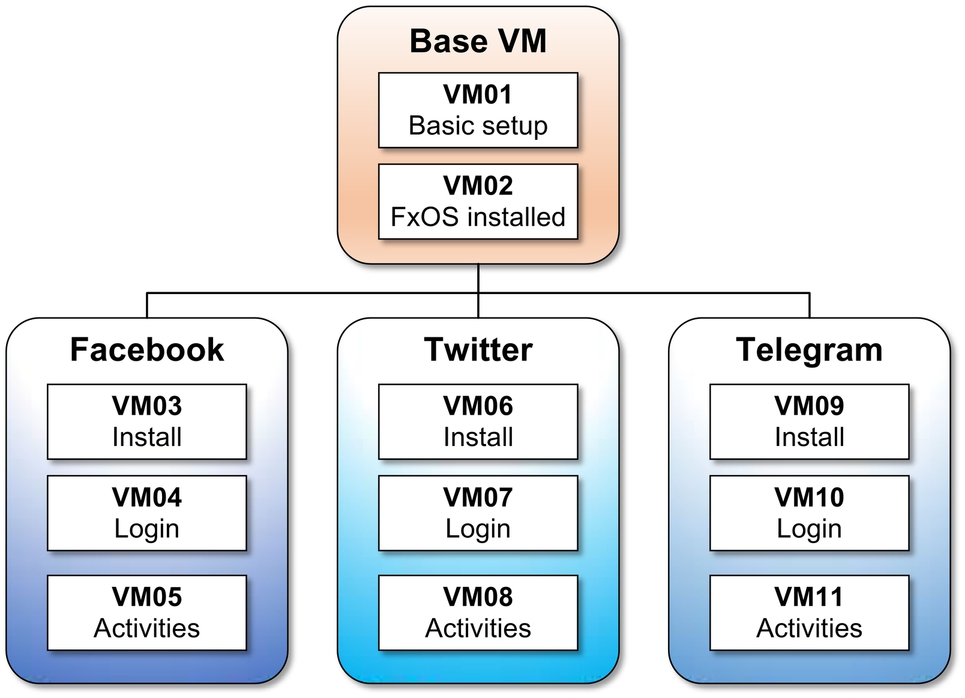
In general, the VMs were grouped into four groups which are Base, Facebook, Twitter, and Telegram groups. The Base VM01 consists of standard OS setup. From this point the disk was copied and the Firefox browser, as well as the FxOS simulator, were installed in VM02. The following three VMs are copies of VM02 that were configured with applications of interest (Facebook (VM03), Twitter (VM06), and Telegram (VM09)) and named accordingly. The remaining VMs were created in accordance with scenario experiments out of the first VM disks of each group.
2.2 Executing Activities
Each step of the activities was documented for future reference and to support the soundness of investigation. Every scenario was performed with predefined communication activities as shown in Table 3.
Table 3
Configuration of Virtual Machine With the Communication Activities
| VM Disk | Scenario | Details |
| Base | ||
| VM01 | Base | Base configuration was installed with Windows 8.1 or Ubuntu 14.04 on 20 GB virtual hard drive and 1 GB Ram |
| VM02 | Install Simulator | VM01 was copied. Firefox Browser and FxOS simulator was installed |
| VM03 | Installation | VM02 was copied and Facebook application was installed |
| VM04 | Login process | VM03 was copied and used to login with prepared social media account |
| VM05 | Activities | VM04 was copied and performed posting, comment, like comment, reply comment, send message, add friend, and follow |
| VM06 | Installation | VM02 was copied and Twitter application was installed |
| VM07 | Login process | VM06 was copied and used to login with prepared social media account |
| VM08 | Activities | VM07 was copied and performed tweet, reply tweet, favorite tweet, retweet, use hashtag, follow, and unfollow |
| Telegram | ||
| VM09 | Installation | VM02 was copied and Telegram application was installed |
| VM10 | Registration | VM09 was copied and used to register telegram account |
| VM11 | Activities | VM10 was copied and performed create contacts, send text, reply text, received picture, and share location |

To initiate logins, we created a dummy account with email and password of [email protected] and “najwadi87,” respectively. For instant messaging account, we registered the account using mobile number “+60162444415” communication with another mobile number “+60125999159.”
2.3 Capturing Network Activities
The objective of this analysis was to identify the correct traffic path for several famous communication activities in mobile phone. From the packets, we need to identify what data can be seen in network traffic, what protocols were being used, who issued the certificates, and what credentials are able to be captured. In this experiment we run the FxOS simulator in the VM player. All network traffic from the FxOS simulator were captured once with Wireshark 1.12.5 and another time using Microsoft Network Monitor 3.4 as a backup capturing tool. In order to capture the network traffic from VM player, VM network adapter was set to NAT. Fig. 3 shows the network packets captured by Wireshark when we executed the communication activities using the FxOS simulator.

Apart from capturing the network activities, we have also saved the virtual memory by copying all virtual memory (.vmem) files generated by VMs. The virtual memory files were copied after performing all the activities prior to shutting down VMs. At the end of experiments we had three files of network packets (.pcap), virtual hard drive (.vmdk), and virtual memory (.vmem) for analysis. However, this paper only reports our analysis of .pcap network traffic files and interested readers may refer to authors previous publications reporting analysis of other files [18,22–24].
2.4 Conducting Network Analysis
Network traffic analysis is the process of capturing, reviewing, and analyzing network traffic for the purpose of security, performance, and management. The process of analyzing the network traffic can be performed manually or using automated techniques. In this paper network packets were analyzed manually using Network Miner 1.6.1 to find the source and destination IP address, communication port, owner of the IP, domain and subdomain, credential, images, certificate used, certificate validity, etc. The detected IP was then checked with an IP address lookup website at http://www.ipchecking.com/, in an attempt to find the owner, hostname, country origin, and reverse DNS.
We also monitored and analyzed the packets using Wireshark 1.12.5 and Microsoft Network Monitor 3.4 to detect the timestamp, flow of handshakes for SSL encrypted traffic, and to extract the certificate (in $NetworkMiner_1-6-1AssembledFiles folder according the source IP subfolder). Fig. 4 shows an example of a certificate retrieved from communication with Facebook.
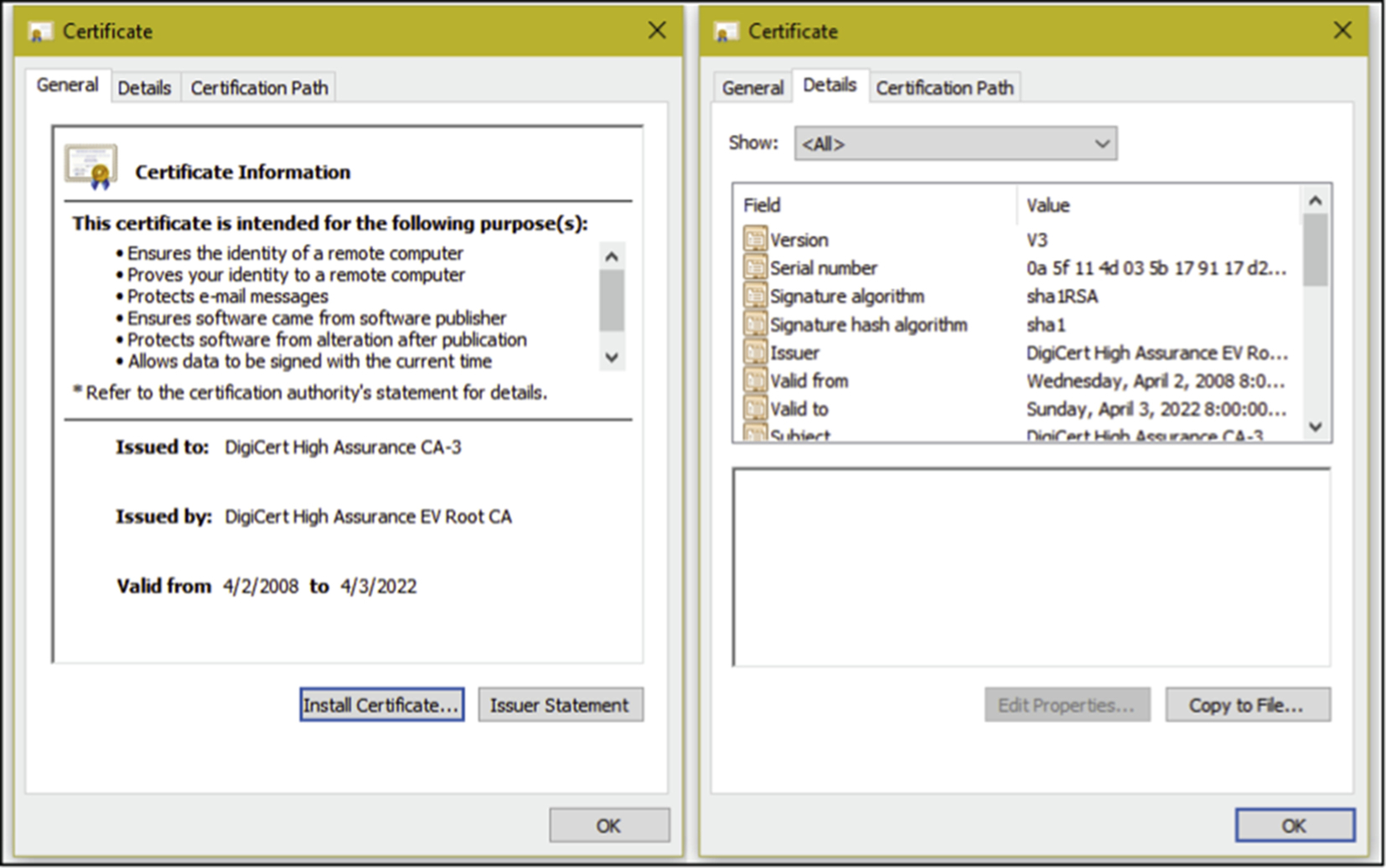
3 Discussion and Analysis
First our network analysis started by observing the network traffic during installation of FxOS simulator. This simulator was installed as an add-on in the Firefox browser. To install the simulator, we navigated to the Firefox add-on download page, and searched for the FxOS simulator. The moment we click the “+ Add to Firefox” button, the initial connection was established on “download.dynect.mozilla.net” with the observed IP of 63.245.217.39 over the port 80. This IP was registered to Mozilla and we also managed to capture all account credentials with the username of “_ga = GA1.2.389580134.1432816473” without any password required for the login process.
During the downloading process, we saw high traffic movement from “*.cdn.mozilla.net” with the observed IP of 68.232.34.191 over the port 443. The connections were encrypted and the certificate was issued by DigiCert High Assurance CA-3. In addition, we also detected network traffic from “aus4.mozilla.com” with the observed IP of 63.245.217.43, 63.245.217.138, and 63.245.217.219 over the port 80 but no data of forensic evidence worth was captured. Our next step was to observe and analyze the network movement for each of our selected applications.
3.1 Network Analysis of Facebook
Facebook is one of the most highly used social network applications across all mobile platforms. A forensic investigation of Facebook contained huge amounts of worthy forensic evidence. A network analysis for Facebook applications consisted of three stages starting from the application installation, credential login, and communication activities was performed using Facebook application in FxOS. VM disks were created for the installation, credential login, and communication activities stages for ease of organizing and monitoring purposes. When accessing the FxOS marketplace, the initial session was established on “marketplace.firefox.com” with the observed IP of 63.245.216.131 over the port 80. The network movements were also detected on port 443 simultaneously and its certificates were issued by DigiCert SHA2 Extended Validation Server CA and DigiCert High Assurance EV Root CA. In addition for this case, we also detected network traffic from the Google Internet Authority with the observed IP of 216.58.210.46. These services were encrypted, whereas their certificates were issued by Google Internet Authority G2, GeoTrust Global CA, and Equifax Secure Certificate Authority.
When browsing the application list in the marketplace, we again saw the network traffic from “*.cdn.mozilla.net” with the observed IP of 68.232.34.191 over the port 443, the same IP server when we downloaded the simulator. Once we found the Facebook application in the list, we clicked its icon and we then received the packet from “m.facebook.com” with the observed IP of 31.13.90.2 over the port 443. Twelve packets were received when we clicked the icon and the certificates were from DigiCert High Assurance CA-3 and DigiCert High Assurance EV Root CA. Next we captured the network traffic coming from “addons.dynect.mozilla.net” and “services.addons.mozilla.org” with the observed IP of 63.245.216.132 and 63.245.216.134 over the port 443 respectively. Both certificates were issued by DigiCert High Assurance EV CA-1. The marketplace was prompted for installation once we clicked the icon. The moment we accepted the application installation, we received the packet from “*.akamai.net” and “*.edgesuite.net” with the observed IP of 176.255.203.* over the port 80 and 443 simultaneously. This IP belongs to Facebook and the certificates were issued by Baltimore CyberTrust Root, GTE CyberTrust Global Root, and Cybertrust Public SureServer SV CA. We also detected network traffic from “marketplace.firefox.com” and “*.cdn.mozilla.net” over the port 443 during the Facebook application installation. As usual, the Facebook icon was created at the home screen as soon as the installation has finished.
Next when we opened the Facebook application, we received the packets again from “m.facebook.com.” The Facebook application directed us to the login page and we used the prepared Facebook account to login. The login process for the Facebook application caught our attention. Immediately after we clicked the login button, the traffic were encrypted and the packet captured were from “safebrowsing.cache.l.google.com” with the observed IP of 90.222.188.* over the port 443. The certificates were issued by Google Internet Authority G2, GeoTrust Global CA, and Equifax Secure Certificate Authority. These services were used to check malicious activities that downloaded and installed malicious software without the user consent. Repeating login process multiple times showed randomness of checking process as we could observe the packets only twice!
After successfully authenticating our test account, we scrolled down to the Facebook newsfeed and we identified the captured packet again came from “*.akamai.net,” “fbcdn-profile-a.akamaihd.net,” and “fbcdn-photos-c-a.akamaihd.net.edgesuite.net” with the observed IP of 176.255.203.* over the port 80 and 443. Various issuer of certificates such as from Cybertrust Public SureServer SV CA, GTE Cybertrust Global Root, and Baltimore Cybertrust Root were identified. The packets from this server were carrying Facebook images, text, as well as other encrypted communications. We performed several Facebook activities such as post a status, post a picture, comment, and like a friend's status, send Facebook private message, received private message, user search, and post an emoticon. All of these activities came from “*.akamai.net,” “fbcdn-profile-a.akamaihd.net,” and “fbcdn-photos-c-a.akamaihd.net.edgesuite.net.” On the other hand, network traffic from Google services such as Google Analytic and Google Internet Authority were captured; starting from the moment we open the marketplace until the end of our experiment. The same network traffic was also observed in the Ubuntu experiment. Table 4 shows the summary of our observed IPs together with their registered organization, country of origin, and certificate issuers for the Facebook experiment.
Table 4
Observed IP and Registered Organization for Facebook Experiment
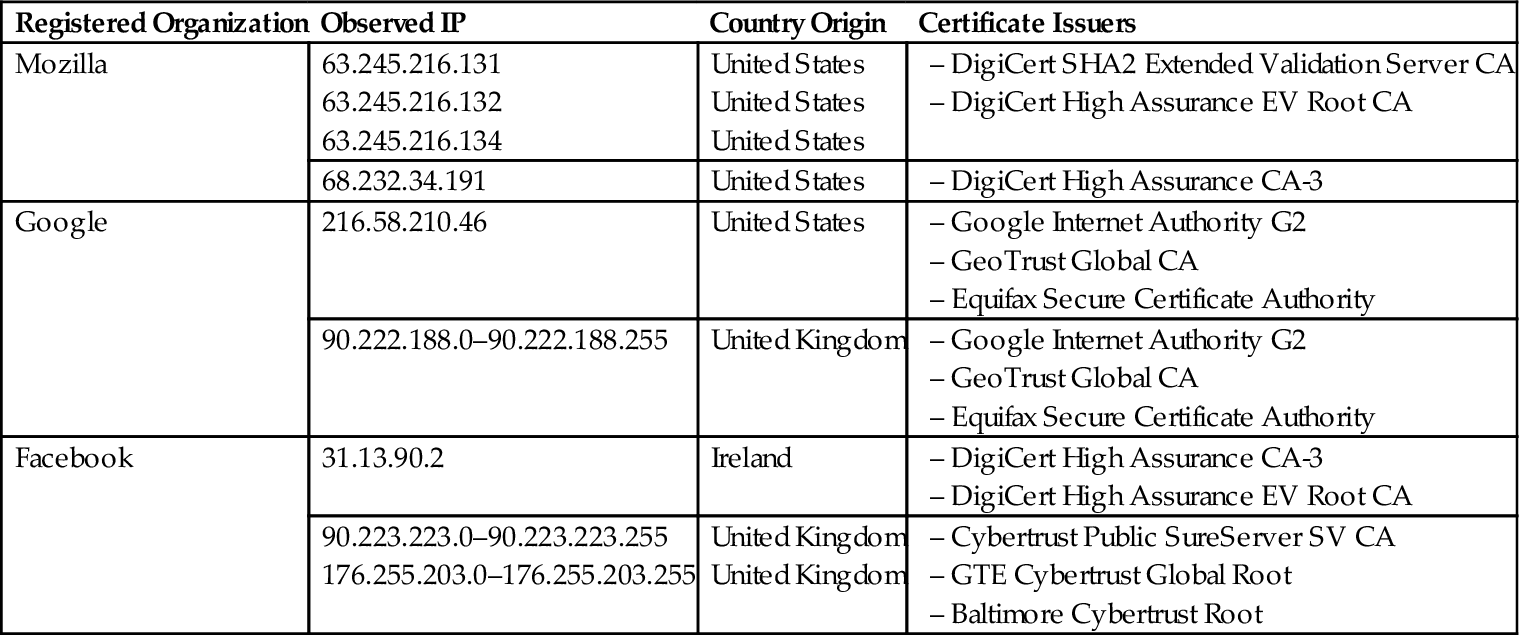
3.2 Network Analysis on Twitter
A network analysis of the Twitter application followed the same steps as the Facebook application; it consisted of three stages starting from the application installation, credential login, and communication activities using the Twitter application in FxOS. VM disks were created for the installation, credential login, and communication activities stages for ease of organizing and monitoring purposes. We again needed to access the FxOS marketplace in order to install the Twitter application. The packets were captured again from “marketplace.firefox.com” with the observed IP of 63.245.216.131 over the port 80 and 443 simultaneously. For encrypted packets, the certificates were issued by DigiCert SHA2 Extended Validation Server CA and DigiCert High Assurance EV Root CA. Similarly, we also detected network traffic from the Google Internet Authority with the observed IP of 216.58.210.78 for this case. These services were encrypted, whereas their certificates were issued by Google Internet Authority G2, GeoTrust Global CA, and Equifax Secure Certificate Authority.
Likewise we again saw the network traffic from “*.cdn.mozilla.net” with the observed IP of 68.232.34.191 over the port 443 when we browsed the application list in Mozilla Marketplace and the certificate was issued by DigiCert High Assurance CA-3. However, we captured a different source of packets when we clicked on the Twitter icon. The packets we received were from “mobile.twitter.com” with the observed IP of 185.45.5.37 and 185.45.5.48 over the port 443. Both IP's certificates were issued by Symantec Class 3 Secure Server CA-G4 and Symantec Class 3 Public Primary Certification Authority-G5. We also managed to capture the network traffic from “addons.dynect.mozilla.net” and “services.addons.mozilla.org” with the observed IP of 63.245.216.132 and 63.245.216.134 over the port 443 respectively, which were the same packets at the same stage during our previous experiment. At the point we accepted for application installation, we received the packets from “ocsp.ws.symantec.com.edgekey.net” and “ss.symcd.com” with the observed IP of 23.54.139.27 over the port 80. This server was transmitting the application data from the server hosted by Akamai Technologies, a cloud service provider based in the United States. As usual, network traffic came from Google services, in addition traffic from “marketplace.firefox.com” and “*.cdn.mozilla.net” over the port 443 were also detected during the Twitter application installation. The Twitter icon was created at the home screen as soon as the installation was finished.
Next when opening the Twitter application, we received the packets again from “mobile.twitter.com.” Furthermore, we also managed to capture the packets from “cs139.wac.edgecastcdn.net” and “*.twimg.com” with the observed IP of 68.232.35.172 over the port 443. The certificates were issued by DigiCert High Assurance EV Root CA and DigiCert SHA2 High Assurance Server CA. From our investigation these servers belong to Twitter. Similar to Facebook application, the Twitter application also directed us to the login page and we used the preprepared Twitter account to login. For the Twitter application, immediately after we clicked login button, the traffic was encrypted and we also managed to capture the packet from “safebrowsing.cache.l.google.com” with the observed IP of 90.222.188.* over the port 443. The certificates were issued by Google Internet Authority G2, GeoTrust Global CA, and Equifax Secure Certificate Authority. These services were used to check downloaded and installed malicious software without user consent. In contrast to Facebook, we managed to capture this packet every time we login to the Twitter application. We continually received a packet from “mobile.twitter.com” while the login process taking place.
After successfully logged into our test account, we then scrolled down to the Twitter newsfeed and managed to capture the packets from “*.twimg.com” with the observed IP of 199.96.57.7 over the port 80 and 443 simultaneously. Previously we identified the packets from “*.twimg.com” but the source IP was different. The certificates were also issued by DigiCert High Assurance EV Root CA and DigiCert SHA2 High Assurance Server CA. The packet from this server carried Twitter images, text, as well as other encrypted communication. Next we performed several Twitter activities such as tweet, reply tweet, retweet, follow, and unfollow user, direct message, view profile, create hashtag, and perform user search. All of these activities came from “mobile.twitter.com” and “*.twimg.com.” Similar to the Facebook application, network traffic from Google services such as Google Analytic and Google Internet Authority were captured starting from the moment we opened the marketplace until the end of our experiment. Table 5 shows the summary of our observed IP together with their registered organization, country of origin, and certificate issuers for the Twitter experiment.
Table 5
Observed IP and Registered Organization for Twitter Experiment
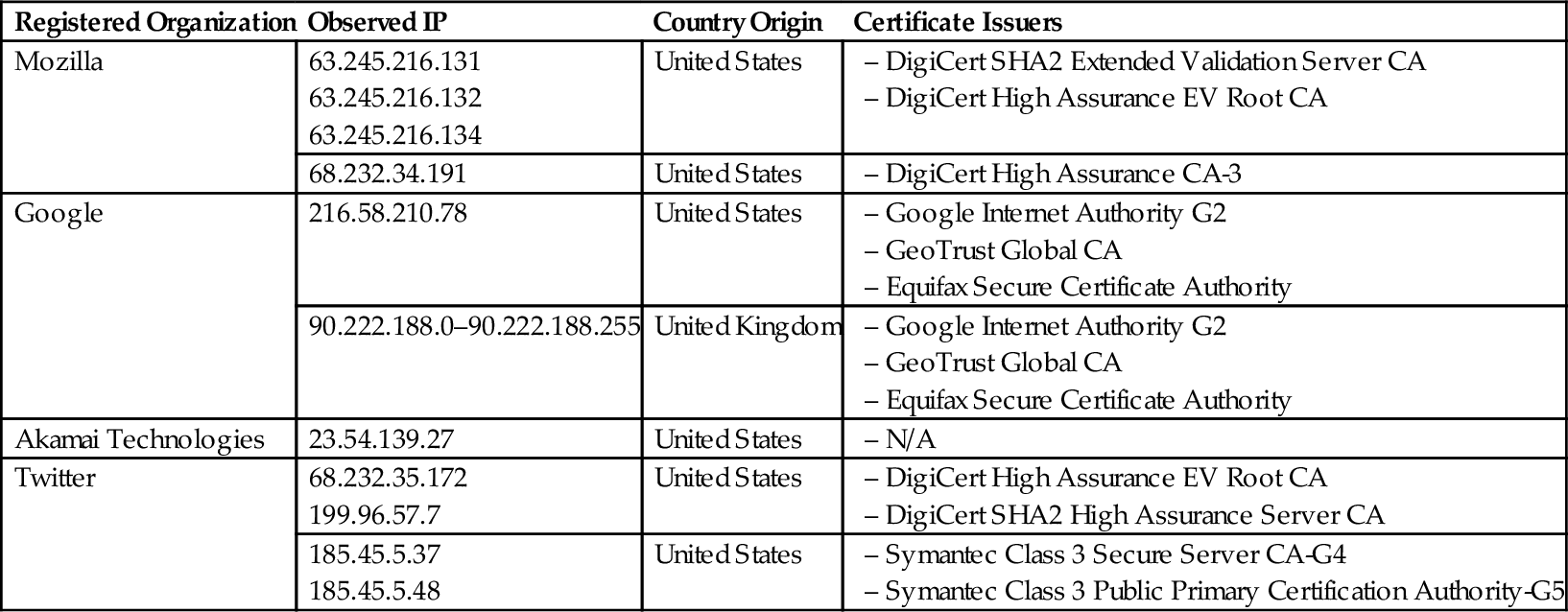
3.3 Network Analysis on Telegram
Telegram was the only instant messaging application that we used in our experiment. Following the same steps for Facebook and Twitter application, this experiment also consists of three stages starting from the application installation, credential login, and communication activities using Telegram application in FxOS. VM disks were created again for the installation, credential login, and communication activities stages to ease the organizing and monitoring purposes. During installation of the Telegram application, the packets were captured again from “marketplace.firefox.com” with the observed IP of 63.245.216.131 over the port 80 and 443 simultaneously when we opened Mozilla Marketplace application from the FxOS simulator. For encrypted packets, the certificates were issued by DigiCert SHA2 Extended Validation Server CA and DigiCert High Assurance EV Root CA.
Next when we browsed and searched the Telegram application in Mozilla Marketplace, we saw again the network traffic from “*.cdn.mozilla.net” with the observed IP of 68.232.34.191 over the port 443 with the certificate was issued by DigiCert High Assurance CA-3. When we clicked the Telegram icon, we received the installation data from “download.cdn.mozilla.net” with the observed IP of 93.184.221.133 over the post 80. We also managed to capture the network traffic from “addons.dynect.mozilla.net” and “services.addons.mozilla.org” with the observed IP of 63.245.216.132 and 63.245.216.134 over the port 443 respectively, which were the same packets at the same stage during our previous experiment. The same as previous experiment, network traffic from “marketplace.firefox.com” and “*.cdn.mozilla.net” over the port 443 have also been detected during Telegram application installation. The Telegram icon was created at the home screen as soon as the installation finished.
Next we then opened the Telegram application and to our surprise, we received the packet from “marketplace.firefox.com” with the observed IP of 63.245.216.131. Normally this packet is received when we clicked on the Mozilla Marketplace icon. When the application was executed, we proceeded with the Telegram phone number registration. The moment the phone number and country were selected, we received a packet from “addons-blocklist-single1.vips.phx1.mozilla.com” with the observed IP of 63.245.217.113 over the port 80. Then clicking the next button and while the Telegram application was generating the registration key, we received the network traffic from “telegram.org” with the observed IP of 149.154.167.51 over the port 80. A registration code was received and our network capturing software recorded incoming network traffic again from “telegram.org” but with different observed IP which was 149.154.167.91 over the port 80. At the same time we also received the network traffic from “*.us-west-2.compute.amazonaws.com” with the observed IP of 52.24.145.20 over the port 443. The certificates were issued by DigiCert Global Root CA and DigiCert SHA2 Secure Server CA. When we repeated our experiment with Ubuntu, the same traffic came through when we received registration key for Telegram. Therefore we can conclude that this server was used to push and generate the registration key for Telegram. In contrast to the Facebook and Twitter network analysis, we were no longer received the network traffic from “safebrowsing.cache.l.google.com” with the observed IP of 90.222.188.* during our experiment. This is because Telegram is only involved with messaging services and no browsing mechanisms were included.
After the registration process was completed, we performed several communication activities such as creating a new contact, opening chat windows, creating group, and sending messages to other contacts. During these activities, we received the network traffic from “telegram.org” with the observed IP of 149.154.171.* over the port 80. When we received a message from another contact, incoming traffic was from “github.map.fastly.net” with the observed IP of 185.31.19.133 over the port 443. The certificates were issued by DigiCert High Assurance EV Root CA and DigiCert SHA2 High Assurance Server CA. We then continued our experiment by sharing our location to our contact and the network traffic was recorded from Google Internet Authority with the observed IP of 216.58.209.234 over the port 443. These services were encrypted, whereas their certificates were issued by Google Internet Authority G2, GeoTrust Global CA, and Equifax Secure Certificate Authority. Finally we ended our experiment by playing the song received from another contact and again, we received the network traffic from “*.us-west-2.compute.amazonaws.com” with the observed IP of 52.24.145.203 over the port 443. Table 6 shows the summary of our observed IP together with their registered organization, country of origin and certificate issuers for Telegram experiment.
Table 6
Observed IP and Registered Organization for Twitter Experiment

4 Conclusion and Future Works
Network analysis is a vital piece in conducting mobile forensics. In this paper, we have successfully presented the network analysis of two popular social networking applications (Facebook and Twitter) and one instant messaging application (Telegram) on FxOS. The findings of this study reported valuable forensics evidence such as image files, communication texts, and authentication credentials detectable in the network traffic. Fortunately, the captured credentials were not in plaintext. Communications in Telegram were transmitted over port 80 in plain text. However, all communication activities in Facebook and Twitter were encrypted and transmitted over port 443. The other conclusion drawn from this research was that not all service providers are storing client data on their servers, i.e., Twitter is using the cloud services from Akamai Technologies to store their installation files. Multiple certificates were carved from the packets namely Mozilla used the certificates from DigiCert; Google from Google Internet Authority; Facebook and Twitter from DigiCert.
This research has brought about many questions in need of further investigation. More information of the FxOS applications investigation would help us to establish a greater degree of network traffic forensic accuracy. Further research opportunities include undertaking the process outlined in this research for cloud storage services. Previous forensic investigation on cloud storage services generally used the cloud storage applications on Apple iOS and Google Android as case studies. Therefore the presence of FxOS will increase in-depth study of FxOS forensics in the cloud storage forensic area. In addition, this research is the first forensic investigation to use the phone simulator in order to monitor network traffic on mobile phone. A future study of investigating network traffic on other mobile OS using phone simulator would be very interesting.
